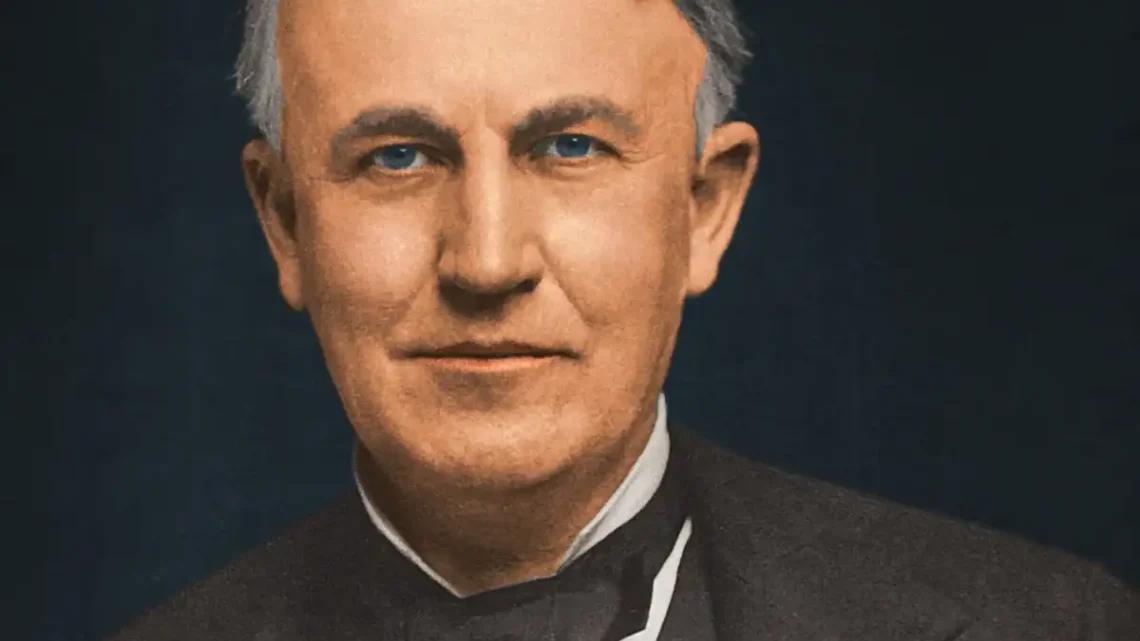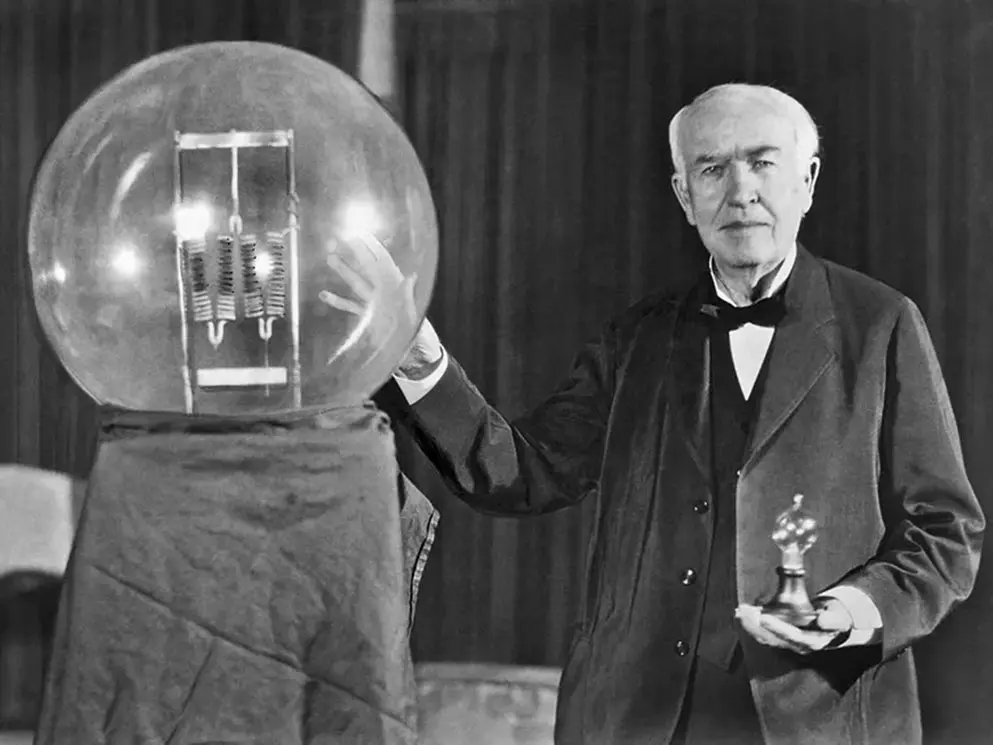
Thomas Edison Biography: Age, Net Worth, Wife, Children, Height, Light Bulb, Inventions, Parents
Biography
Thomas Alva Edison (1847–193, Milan, Ohio – 1931, West Orange, New Jersey) was a celebrated American inventor and businessman widely regarded as one of history’s most prolific innovators.
He held 1,093 U.S. patents and pioneered practical electric lighting with the first commercially viable incandescent light bulb (1879), developed the phonograph (1877)—the first device to record and reproduce sound—and co-founded General Electric.
Trending Now!!:
Edison also established the world’s first industrial research laboratory in Menlo Park, New Jersey, earning him the nickname “The Wizard of Menlo Park.”
Though largely self-educated and hearing-impaired from childhood, he developed a systematic approach to invention and a relentless work ethic that revolutionized modern technology, communication, and entertainment.
| American inventor and businessman | |
| Thomas Edison | |
|---|---|
 | |
| Wiki Facts & About Data | |
| Real Name: | Thomas Alva Edison |
| Stage Name: | Thomas Edison |
| Born: | 11 February 1847 (age 84 years old) |
| Place of Birth: | Milan, Ohio, United States |
| Died: | 18 October 1931 (age 84 years), West Orange, New Jersey, United States |
| Nationality: | American |
| Education: | Princeton University |
| Height: | 1.77 m |
| Parents: | Nancy Matthews Elliott, Samuel Ogden Edison Jr |
| Siblings: | Samuel Edison Jr., Hezekiah Edison, Solomon Edison, John Edison, Mary Edison, Carl Edison |
| Spouse: | Mina Miller Edison (m. 1886–1931), Mary Stilwell (m. 1871–1884) |
| Girlfriend • Partner: | Not Dating |
| Children: | Charles Edison, Theodore Miller Edison, Thomas Alva Edison Jr., Madeleine Edison, Marion Estelle Edison, William Leslie Edison |
| Occupation: | Inventor • Businessman |
| Net Worth: | $240 million-$250 million (USD) |
Early Life & Education
Thomas Alva Edison was born on February 11, 1847, in Milan, Ohio, United States.
He was the seventh and youngest child of Samuel Ogden Edison Jr., a Canadian-born shingle maker and land speculator of Dutch ancestry who had fled to the United States after participating in a failed rebellion, and Nancy Matthews Elliott, a former schoolteacher from New York with Scottish roots.
The family, which included six older siblings, Samuel Edison Jr., Hezekiah Edison, Solomon Edison, John Edison, Mary Edison, and Carl Edison (though only three survived to adulthood beyond early childhood losses), relocated to Port Huron, Michigan, when Edison was seven years old due to economic hardships following the decline of Milan’s canal-based economy.
Ethnically, Edison‘s patrilineal line traced back to Dutch origins via New Jersey, blended with his mother’s Anglo-Scottish heritage.
Regarding religion, Edison developed freethinking views early on, influenced by his parents’ ownership of works by Thomas Paine; he later identified more with scientific deism, believing in a guiding intelligence in the universe but rejecting organized theology and traditional notions of God.
His education was minimal and informal: after just a few months in public school—where a teacher labeled him “addled” due to his restless curiosity and partial deafness (possibly from scarlet fever or a childhood accident)—he was homeschooled by his mother, who taught him reading, writing, and arithmetic.
This self-directed learning sparked his lifelong passion for experimentation, particularly after receiving a science book from her that inspired his first electrical tinkering at home.
By age 12, Edison began working on railroads to support the family, selling newspapers and candy while conducting chemical experiments in a makeshift lab in a baggage car, marking the start of his inventive pursuits.
Thomas Edison received minimal formal schooling; he attended for only a few months and was homeschooled by his mother, a former teacher. His education was largely self-taught through extensive reading and experimentation, a path he pursued throughout his life.
Later in his life, he was awarded an honorary degree from Princeton University in 1915, although he never attended college.
Career
Thomas Edison’s career began remarkably early. At just twelve years old, in 1859, he started selling newspapers and candy on trains running between Port Huron and Detroit.
Resourceful from the start, he converted a baggage car into a small laboratory and even printed his own newspaper on board—an enterprise that ended after an accident damaged his equipment and further affected his hearing.
By his mid-teens, he had taught himself telegraphy, and between 1863 and 1868, he traveled across the Midwest and Canada working as an itinerant telegrapher, constantly experimenting with the devices he used.
Edison secured his first patent in 1869 at age twenty-two: an electric vote-recording machine that lawmakers ignored, teaching him an early business lesson—focus on inventions people actually want. That same year, he moved to New York City, where he quickly built a reputation for improving stock-ticker machines.
Soon, he was operating major workshops in Newark, New Jersey, developing duplex and quadruplex telegraphy, creating the electric pen (a precursor to the mimeograph), and inventing the carbon microphone transmitter that allowed Alexander Graham Bell’s telephone to function reliably.
In 1876, Edison founded the world’s first industrial research laboratory at Menlo Park, New Jersey. Within a year, he introduced the carbon-button phonograph, the first machine capable of recording and playing back sound, earning him the nickname “The Wizard of Menlo Park.”
He followed this triumph by tackling electric lighting. After thousands of tests, his lab produced a practical carbon-filament incandescent bulb in 1879 and designed an entire electric-lighting system—including generators, meters, parallel circuits, and wiring—making large-scale electric service possible.
In 1882, he opened the Pearl Street Station in lower Manhattan, the first central power plant to deliver electric light to paying customers and the true start of the electrical age.
Edison expanded to an even larger laboratory in West Orange, New Jersey, in 1887. During the “War of the Currents,” he fiercely championed his direct-current system against the alternating-current approach promoted by George Westinghouse and Nikola Tesla—a technological clash he ultimately lost but one that captivated the world.
At West Orange, he refined the motion-picture camera and the kinetoscope viewer, built the rotating “Black Maria” film studio, and produced some of America’s earliest movies. He also spent years developing a nickel-iron storage battery, launched a major cement-manufacturing venture using massive rotary kilns of his own design, and, during World War I, searched for domestic sources of natural rubber.
Through his many companies—some of which eventually helped form General Electric—Edison became one of the wealthiest industrialists in the country, while continually reinvesting in research. He remained inventive throughout his life, receiving his 1,093rd U.S. patent just weeks before his death on October 18, 1931, at age eighty-four.
Edison’s career reshaped modern life by turning invention into an organized, team-based enterprise and by delivering innovations such as sound recording, electric light and power, motion pictures, and countless other technologies that define daily living today.
Personal Life
Thomas Alva Edison married twice during his lifetime, first wedding Mary Stilwell on Christmas Day 1871 when he was twenty-four and she was just sixteen, having met her only two months earlier as an employee in one of his Newark shops; their union lasted until her untimely death in 1884 at age twenty-nine, possibly from a brain tumor or an overdose of morphine prescribed for her ailments.
Three years later, in 1886, Edison remarried to twenty-year-old Mina Miller Edison, the daughter of affluent Ohio inventor and philanthropist Lewis Miller, whom he had courted briefly after meeting her at a Chautauqua retreat; they remained together until he died in 1931, with Mina outliving him by sixteen years and taking on much of the family management at their Glenmont estate in New Jersey.
From his first marriage to Mary, Edison fathered three children: daughter Marion Estelle Edison (born 1873 and nicknamed “Dot” after Morse code), son Thomas Alva Edison Jr. (born 1876, nicknamed “Dash,” who later struggled with alcoholism and failed business ventures, prompting Edison to legally bar him from using the family name for commercial purposes), and son William Leslie Edison (born 1878, who became an inventor himself after graduating from Yale).
With his second wife Mina, he had another three offspring: daughter Madeleine Edison (born 1888, who married and had children but recalled little of her often-absent father), son Charles Edison (born 1890, who attended MIT, succeeded his father in running the Edison companies, and later served as Governor of New Jersey from 1941 to 1944), and son Theodore Miller Edison (born 1898, also an MIT physics graduate who pursued independent inventing and lived until 1992).
Physically, Edison stood at approximately five feet ten inches tall (1.77 m), an average height for men of his era, though he was notably hearing-impaired from around age twelve due to scarlet fever or recurrent ear infections, which he claimed helped him concentrate on his work by blocking out distractions.
Edison was not known for extensive romantic pursuits, given his intense focus on invention and business; he met Mary quickly through work and married her soon after, while his courtship of Mina began in late 1884 at an exposition in New Orleans, continued through visits in Boston and a religious gathering at Chautauqua in 1885 where overt flirting was restrained, and culminated in a proposal during a September mountain trip that year, leading to their swift marriage—reflecting a practical rather than prolific approach to relationships amid his demanding career.
Cause of Death
Thomas Alva Edison died on October 18, 1931, at his home, Glenmont, in Llewellyn Park, West Orange, New Jersey. He was 84 years old, having lived from February 11, 1847, to just eight months short of his 85th birthday.
For the last decade of his life, Edison had suffered from a combination of serious illnesses, including Bright’s disease (chronic nephritis), gastric ulcers, and advanced diabetes mellitus.
By the summer of 1931, his diabetes had spiraled out of control, leading to diabetic coma episodes in August and September. He rallied briefly after insulin treatment and blood transfusions, but his kidneys failed completely.
On October 14, he slipped into a final uremic coma from which he never regained consciousness, dying peacefully four days later at 3:24 a.m. with his wife Mina and several of his children at his bedside.
His physician, Dr. Hubert S. Howe, recorded the immediate cause of death as uremia secondary to diabetic nephropathy and arteriosclerotic heart disease.
At Edison’s own request, there was no autopsy; his body was embalmed and lay in state at his West Orange laboratory before a private funeral and burial in the family plot behind Glenmont.
Net Worth
Thomas Edison died in 1931, leaving an estate valued at roughly $12 million, equivalent to about $240 million to $250 million in today’s money.
At his peak in the late 1920s, he ranked among America’s fifty or sixty richest individuals. His wealth came primarily from his large stake in Edison General Electric (the forerunner of General Electric), royalties on motion-picture apparatus, earnings from the Edison Portland Cement Company, and dividends from the many other enterprises he had founded or controlled over the decades.
Because he habitually plowed profits back into ever-larger laboratories and fresh experiments rather than hoarding cash, his fortune rose and fell dramatically during his lifetime and remained far smaller than those of contemporaries such as Henry Ford or John D. Rockefeller.
NOTICE!! NOTICE!! NOTICE!!
At TheCityCeleb, we strive to provide accurate and up-to-date biographies and entertainment news, focusing on celebrities. Our editorial team researches information from reputable sources, including interviews, official statements, and verified media.If you spot an error or have additional details, please contact us at editor@thecityceleb.com. We value your feedback and are committed to maintaining trustworthy content.

